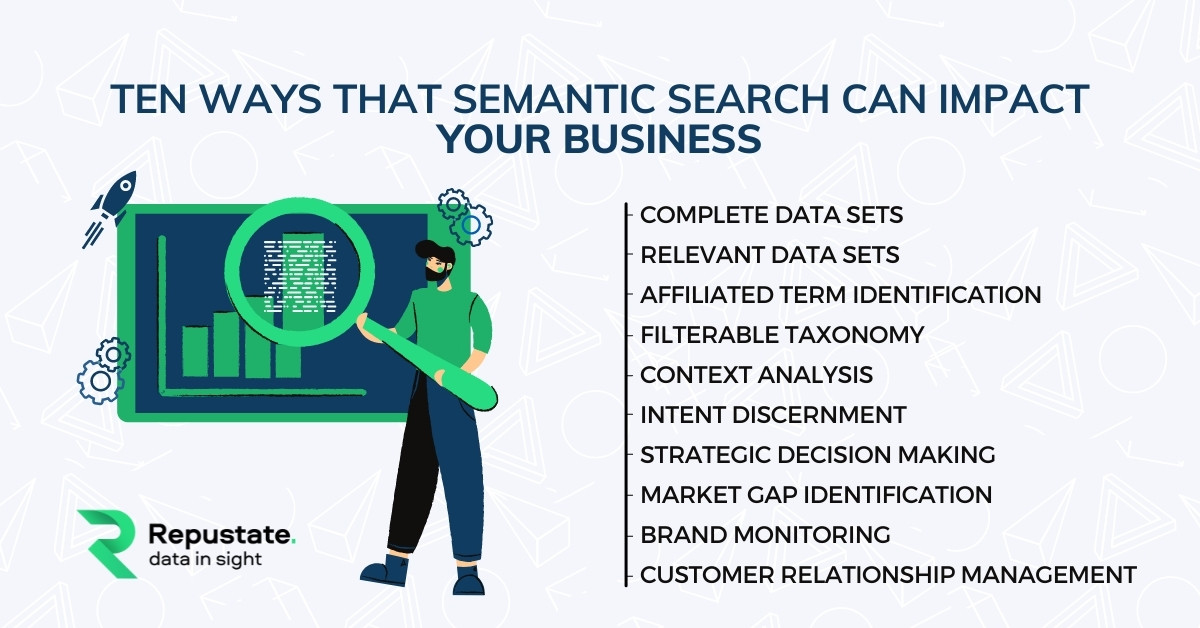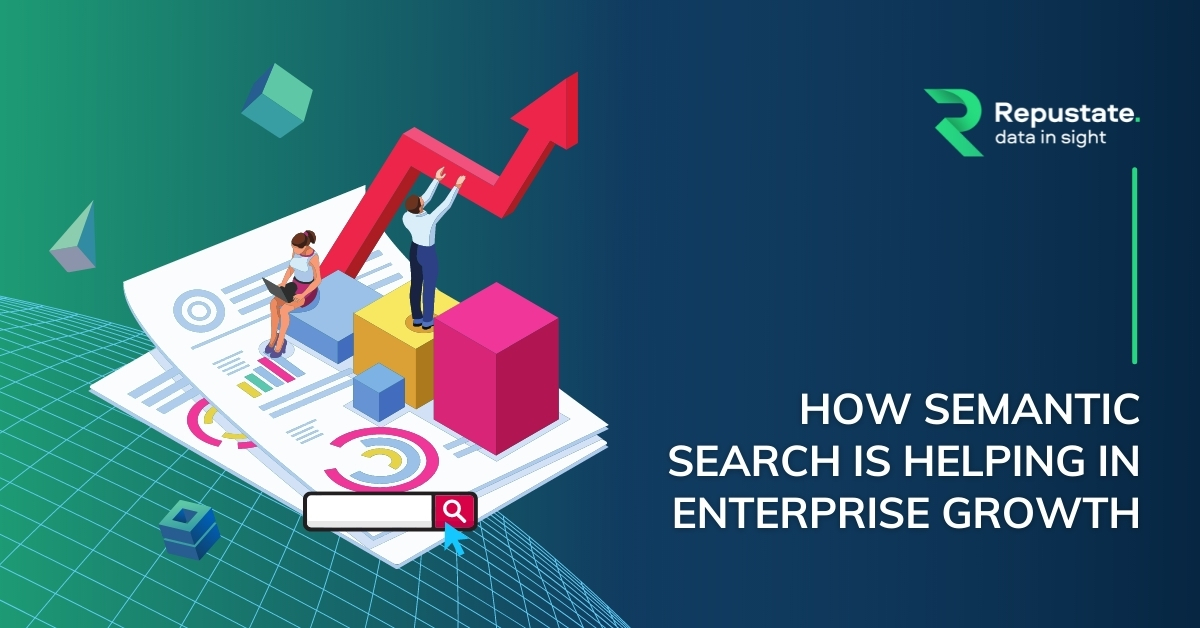How Semantic Search is helping in Enterprise Growth
In this article, we explore how Semantic Search is helping enterprises in getting ready for the future. Finding what you need as web content expands exponentially requires better and more powerful search engines. For businesses, identifying relevant and helpful data on brand performance, market dynamics, and competitor pricing, to name but three topics is much improved when you utilize the power of AI and machine learning to sift through big data.
Semantic Search is making sophisticated data analysis possible for even small to medium-sized businesses across the world. Less than ten years old, and first explored with Google’s Hummingbird update, Semantic Search has finally come of age.
How is Semantic Search Helping Businesses Grow?
To gain a competitive edge, businesses must leverage market intelligence, consumer insight, and product research to find out what potential customers want and don’t want. To do so, techniques such as data scraping and textual analysis are commonly used to retrieve large quantities of data and displayed in graphical form to demonstrate trends, market gaps, and potential problems.
However, when search capability is limited to keyword strings, the data quality is variable at best. Semantic Search incorporates an understanding of the context in which language functions. For example, with first-generation search engines, if a customer wanted to know how much they would pay for a new electric bike they would input “cost” “new” “electric bike” into a search engine, hit go and hope for the best. The results would be a mixture of the relevant and irrelevant.
By contrast, Semantic Search can understand the sentence “how much is a new electric bike?” because it understands (as we do) that “how much” indicates a question about price, and that “new electric bike” reveals a desire for a new product. The AI underlying the technology can intuit a desire to buy and can therefore serve up content highly focused on that need.
Applications of Semantic Search go further than that. Below we’ll examine the ways in which it can significantly impact your enterprise scale business.
Ten Ways Semantic Search Impacts Your Business

- Complete Data Sets
A Semantic Search will not discount data because words are misspelt or abbreviated, so long as common alternatives are accounted for. It will pull in all the data you require and rank relevance so that you can focus on the information that proves most helpful. An understanding of context allows it not to overlook things that more pedantic and old-fashioned search algorithms might miss and prepares NLP for business applications.
- Relevant Data Sets
Semantic Search’s sophisticated understanding of the meaning behind a string of text, whether extracted from print, audio, or visual content, means that it can identify more accurately the most useful data and present it in a way that evidences strategic decisions and ideas. You can identify trends more quickly and nip problems in the bud. Our video search even enables you to conduct search inside video tasks for relevant snippets and mentions to enable them for labeling & analytics.
- Affiliated Term Identification
Rather than miss common synonyms, Semantic Searches pull in all the alternative ways in which internet users express propositions. You don’t need to search individually for all variants (particularly in a language as rich as English). For instance, it can identify “car” and “automobile” and even every car brand if you so choose (or “voiture”, “jalopy” etc.) It can tell that Bob, Bobby, Rob, and Robert are all potentially the same person.
- Filterable Taxonomy
Once you have the raw data from your Semantic Search, you can apply a range of filters to further improve its accuracy, a feature not always available with a Google search. A good Semantic Search tool will be able to exclude terms, make others mandatory, or simply order by relevance. Once you have the filtered data at hand, the possibilities are endless.
- Context Analysis
Let’s say you need to identify customer complaints about a product. If you apply a Semantic Search to websites displaying product reviews, it will understand the difference between a negative and positive comment, even for customers who did not provide a star rating. This can provide quick and invaluable insights, allowing you to address problems or take advantage of an issue customers have with a competitor’s product.
- Intent Discernment
In business, the customers that are hardest to track are the ones who visit your site, don’t find what they’re looking for, and leave without making a purchase. But if comments are left, Semantic Search can quickly identify the market gap that hasn’t been satisfied or the misunderstanding that led these fleeting visitors to alight on your landing page by mistake.
It can see opportunities that you might otherwise miss – an item of clothing wasn’t available in the right size, or was mispriced, a piece of software didn’t offer a monthly subscription option, etc. Semantic Search digs into the intent behind a customer interaction.
- Strategic Decision Making
Once you have the data at your fingertips, you’ll be able to trace trends and identify common themes. This will help identify new directions to explore, product lines to expand, different groups of customers to appeal to, and so forth. Many Semantic Search tools feature dashboards and reporting tools that allow you to readily share the evidence you’ve found, helping convince executives to adopt strategic pivots and expansions.
- Market Gap Identification
User comments can be hugely helpful in market gap identification, whether in the form of lengthy complaints, queries, or effusive praise. If a question is being asked many times by different users, it seems likely that a gap has been identified, either in the form of information or product provision. To extract this kind of analysis, however, requires a sophisticated search engine, since these comments will often be casually phrased, with typos and abbreviations. Once again, Semantic Search can reach places other engines won’t go.
- Brand Monitoring
Sophisticated Semantic Search can work on spoken word as well as written text too. Want to dig into social media influencers and what they are saying about your product? That’s no problem when your social media listening tool can read context and identify content directly relevant to your brand, even from the video content. Mentions, reviews, and memes can all be identified and corralled with intelligent use of Semantic Search facilities. You’ll keep on top of any problems that accrue, as well as spot opportunities for synergistic marketing – following the lead of your customers. This builds a sense of loyalty and ownership.
- Customer Relationship Management
Finally, the task of Customer Relationship Management (CRM) is made infinitely easier when a Semantic Search tool can aggregate queries, allowing you to address issues at scale. FAQs can be constructed more easily, and complaints answered efficiently and in a timely manner. Compliments and thanks can be helpful too, allowing you to provide “more of the same”, or reward customer loyalty and positive influence. You’ll build a better relationship with customers if you don’t miss the emotions behind the queries, whether your clientele is delighted, confused, frustrated, or furious!
Semantic Search for image, text, or video
Semantic Search isn’t a miracle cure but it is a powerful place to start in market analytics, providing complete, relevant, and meaningful insights into consumer attitudes, desires, and feelings. You’ll never regret incorporating this AI-powered powerhouse into your suite of analytic tools. As opportunities present themselves, you gain a more comprehensive understanding of where your organization sits within the marketplace.
Repustate’s enterprise Semantic Search uses machine learning to apply named entity recognition on each text document, image, or video it analyzes. When you know all of the entities in your data and how they’re associated with each other, relevant information becomes easier and more accurate to discover. Furthermore, the solution can be customized and implemented to suit your needs exactly, integrating seamlessly into your existing tech stack.
 Home
Home
 Jul 6, 2021
Jul 6, 2021

 Jeremy Wemple
Jeremy Wemple
 Dr. Ayman Abdelazem
Dr. Ayman Abdelazem
 Dr. Salah Alnajem, PhD
Dr. Salah Alnajem, PhD
 David Allen
David Allen

 Repustate Team
Repustate Team

